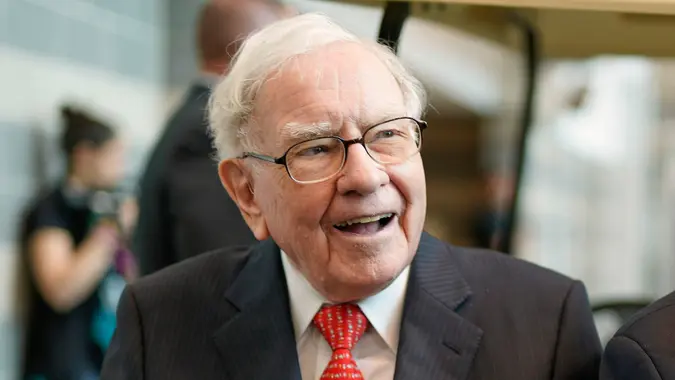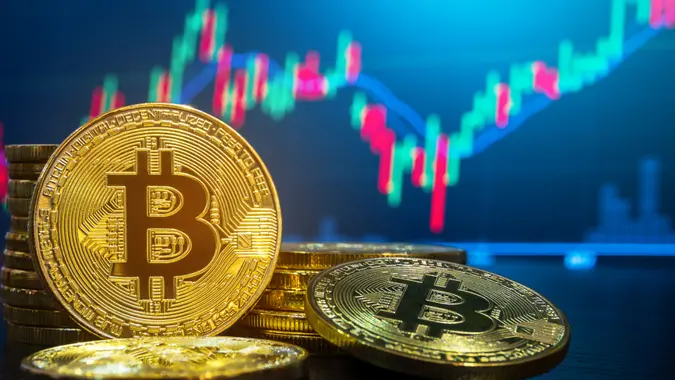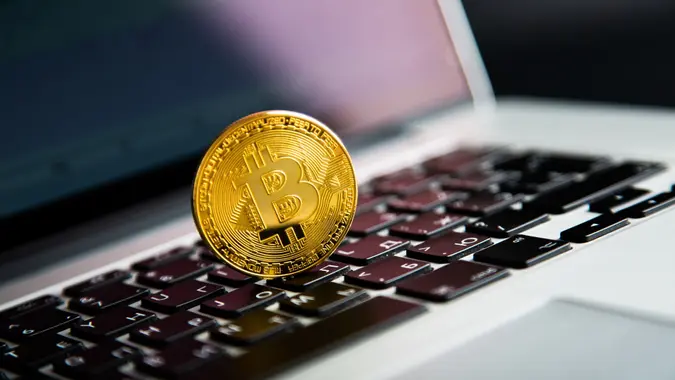Best S&P 500 ETFs To Watch or Invest In Now

Commitment to Our Readers
GOBankingRates' editorial team is committed to bringing you unbiased reviews and information. We use data-driven methodologies to evaluate financial products and services - our reviews and ratings are not influenced by advertisers. You can read more about our editorial guidelines and our products and services review methodology.

20 Years
Helping You Live Richer

Reviewed
by Experts

Trusted by
Millions of Readers
Looking for a simple, low-cost way to grow your money with exposure to top U.S. companies? The best S&P 500 ETFs make investing in America’s largest and most influential businesses easy — all in one fund.
In 2025, these ETFs remain among the most popular and reliable options for beginner and seasoned investors.
This guide breaks down the best S&P 500 ETFs to watch or invest in now, offering a side-by-side comparison, why they matter and how to get started — even if you’re new to investing.
Best S&P 500 ETFs in 2025
Here’s a quick look at some of the best-performing and most popular S&P 500 ETFs this year:
| Stock | Ticker | Total Assets | Expense Ratio |
|---|---|---|---|
| iShares Core S&P 500 ETF | IVV | $587.60 Billion | 0.03% |
| Vanguard S&P 500 ETF |
$649.70 Billion |
0.03% | |
| SPDR S&P 500 ETF Trust | SPY | $605.20 Billion | 0.095% |
| Invesco S&P 500 Equal Weight ETF | RSP | $72.6 Billion | 0.20% |
| Schwab S&P 500 Index Fund | SWPXX | $111.3 Billion | 0.020% |
Bonus Pick: SPYG (SPDR Portfolio S&P 500 Growth ETF)
- Focuses on growth stocks within the S&P 500
- Slightly more volatile but higher upside over time
Why Invest in S&P 500 ETFs?
S&P 500 ETFs track the performance of the 500 largest publicly traded U.S. companies. Here’s why investors love them:
- Diversification: Get exposure to tech, healthcare, finance and more in one fund.
- Cost-Effective: Most S&P 500 ETFs have extremely low fees.
- Passive Investing: No need to pick individual winners — the index does it for you.
- Strong Long-Term Returns: Historically, the S&P 500 delivers solid gains over time.
- Consistent Dividend Income: You have a consistent stream of income that can be reinvested.
Whether you’re saving for retirement or building wealth slowly, these ETFs are a smart core holding.
S&P 500 ETFs vs. Other Investment Options
How do S&P 500 ETFs compare to other investments? Check out this chart that compares S&P 500 ETFs with other investment options:
| Investment Type | Pros | Cons |
|---|---|---|
| S&P 500 ETFs | -Low fees -Good long-term performance -Diversified exposure to top 500 U.S. companies |
-Vulnerable to market downturns -No international exposure -Limited to large-cap stocks |
| Individual Stocks | -Possibility for high returns -Control of your picks are up to you -Can tailor your risk |
-Will have to do research -Risk of larger losses -Less diversified means you take on more risk |
| Bonds | -Possibility for high returns -Control of your picks is up to you -Can tailor your risk |
-Affected by inflation -Lower long-term returns |
| Total Market ETFs | -Steady income -Good for preserving capital |
-Heavier in smaller companies that may not perform well -Slightly more volatile than S&P 500 |
S&P 500 ETFs strike a strong balance between simplicity, performance and risk.
Risks of Investing in S&P 500 ETFs
While they’re a staple in many portfolios, there are still a few risks to keep in mind:
- Market Risk: When the S&P 500 goes down, your ETF likely will too.
- Overweighting Big Names: The index is market-cap weighted, meaning giants like Apple and Microsoft can dominate performance.
- No Downside Protection: These ETFs don’t hedge against downturns — you’re in for the ride.
Consider pairing S&P 500 ETFs with bonds, international funds or sector ETFs to balance things out.
Trends Shaping S&P 500 ETF Investing in 2025
Some trends boosting the popularity of S&P 500 ETFs this year include:
- AI-Driven Growth: Big tech names in the S&P 500 are benefitting from AI investments.
- Steady Interest Rates: Stabilizing rates are making equities more attractive again.
- Retail Investor Growth: More individuals are using ETFs for long-term wealth building.
- Brokerage Competition: Platforms like Fidelity and Schwab offer fractional shares and zero-commission trades.
These trends make 2025 a great time to revisit or begin your S&P 500 ETF strategy.
How to Buy S&P 500 ETFs
Buying S&P 500 ETFs is not complicated. Here is a step-by-step guide on how to do so:
- Step 1: Choose a brokerage platform and fund your account – Choose a platform that allows you to buy S&P 500 ETFs, and link a bank account.
- Step 2: Do your research – Look into different S&P 500 ETFs.
- Step 3: Find the company ticker – Locate the company ticker on the platform.
- Step 4: Decide how much you want to invest – You may want to evaluate your full portfolio before investing. Talk to a financial planner if you’re unsure of what investment to make.
- Step 5: Place an order – Choose the number of shares and amount. Then, confirm your order.
- Step 6: Track your investment – Monitor your investment in your overall portfolio and make adjustments as necessary.
Final Take to GO
The best S&P 500 ETFs in 2025 give you an easy, affordable way to invest in the U.S. economy’s most powerful companies. With low fees, strong historical returns and broad diversification, they belong in almost every portfolio.
Ready to get started? Choose an ETF that fits your budget and platform, invest consistently and let the market do the work.
For more guidance, check out our ETF investing guide or step-by-step guide to opening a brokerage account.
FAQs
With so many ETFs to choose from, picking the best S&P 500 ETFs to invest in now can be difficult. Here's more information that might help you make a decision:- What are the best S&P 500 ETFs for beginners?
- Vanguard S&P 500 ETF (VOO), iShares Core S&P 500 ETF (IVV) and SPDR S&P 500 ETF Trust (SPY) are good S&P 500 ETFs for beginners.
- Should I invest in S&P 500 ETFs in 2025?
- S&P 500 ETFs offer long-term growth, a chance for diversification and the opportunity to earn passive income.
- Which S&P 500 ETFs pay dividends?
- State Street SPDR S&P 500 ETF (SPY), Vanguard S&P 500 ETF (VOO) and iShares Core S&P 500 ETF (IVV) are ETFs that pay dividends.
- Are S&P 500 ETFs good for long-term growth?
- Yes, there is diversified exposure to the top 500 companies and easy to set up with your retirement accounts, as well as having low cost with long-term returns.
Information is accurate as of May 21, 2025.
Editorial Note: This content is not provided by any entity covered in this article. Any opinions, analyses, reviews, ratings or recommendations expressed in this article are those of the author alone and have not been reviewed, approved or otherwise endorsed by any entity named in this article.
Our in-house research team and on-site financial experts work together to create content that’s accurate, impartial, and up to date. We fact-check every single statistic, quote and fact using trusted primary resources to make sure the information we provide is correct. You can learn more about GOBankingRates’ processes and standards in our editorial policy.
- ETF Stream. 2023. "Tactical vs core: How long do fund buyers typically hold an ETF for?"
- RBC GAM. 2024. "Three ways to use core ETFs in your portfolio"
- Proshares. 2024. "Customize an S&P Portfolio. Ex-Sector: Underweight or Exclude a Sector"
- ETF.com. 2024. "Most Popular ETFs by AUM"
- SSGA.com. 2024. "SPDR S&P 500 ETF Trust"
- Stock Anaysis.com. 2024. "ETF Providers"
- BlackRock. 2024. "iShares S&P 500 Equal Weight UCITS ETF"
- Vanguard. 2024. "Vanguard S&P 500 Value ETF"
- VettaFi. "Largest ETFs: Top 100 ETFs By Assets."
 Written by
Written by  Edited by
Edited by 

























